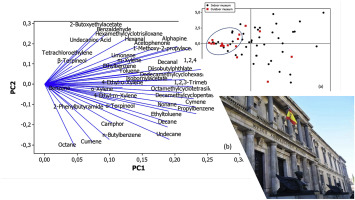当前位置:
X-MOL 学术
›
Build. Environ.
›
论文详情
Our official English website, www.x-mol.net, welcomes your
feedback! (Note: you will need to create a separate account there.)
Volatile Organic Compounds In The Spanish National Archaeological Museum: Four Years Of Chemometric Analysis
Building and Environment ( IF 7.1 ) Pub Date : 2020-05-01 , DOI: 10.1016/j.buildenv.2020.106780 Benigno Sánchez , Murilo de Oliveira Souza , Olga Vilanova , Maria Cristina Canela
Building and Environment ( IF 7.1 ) Pub Date : 2020-05-01 , DOI: 10.1016/j.buildenv.2020.106780 Benigno Sánchez , Murilo de Oliveira Souza , Olga Vilanova , Maria Cristina Canela

|
Abstract The 19th-century building housing the National Archaeological Museum (MAN) of Spain located in Madrid's downtown was remodelled between 2008 and 2014. During the final of the reform and since its opening to the public on April 2014 and until 2017, the levels of forty different Volatile Organic Compounds (VOCs) were determined and quantified following the AirArt project. This project aimed to identify, quantify and treat the chemical and biological pollutants in the museum. This article discusses the presence, quantification and chemometric studies of the main VOCs identified in the museum. The campaigns were carried out by collecting active and passive air samples on sorbent tubes and monitoring the results over four years. The I/O ratio >1 shows that the indoor VOCs concentrations were higher than those at the outdoors of the museum from the emission of new materials used for their renovation. The Egypt and Reinos Cristianos rooms have the highest I/O ratio. The PCA analysis for four years of indoor and outdoor VOCs analysis of the museum explains the difference between the two environments and highlighted the siloxanes and aldehydes like principal VOCs inside the museum. The concentration of these compounds is below the WHO limits, but little is known about the limit and which compounds can damage the heritage in the museums. The filtration system in the airtight showcase ensures the removal of pollutants over time, avoiding damage to both the health of conservatives and the heritage on display.
中文翻译:

西班牙国家考古博物馆中的挥发性有机化合物:四年的化学计量分析
摘要 位于马德里市中心的西班牙国家考古博物馆 (MAN) 所在的 19 世纪建筑于 2008 年至 2014 年间进行了改造。在 AirArt 项目之后,对 40 种不同的挥发性有机化合物 (VOC) 进行了测定和量化。该项目旨在识别、量化和处理博物馆中的化学和生物污染物。本文讨论了博物馆中确定的主要 VOC 的存在、量化和化学计量学研究。这些活动是通过在吸附管上收集主动和被动空气样本并在四年内监测结果来进行的。输入输出比 > 图 1 表明,由于翻新所用的新材料排放,室内 VOCs 浓度高于博物馆室外的 VOCs 浓度。埃及和 Reinos Cristianos 房间的 I/O 比率最高。博物馆四年室内外VOCs分析的PCA分析解释了两种环境之间的差异,并突出了博物馆内主要VOCs的硅氧烷和醛类。这些化合物的浓度低于世界卫生组织的限制,但人们对限制以及哪些化合物会破坏博物馆遗产知之甚少。密闭陈列柜中的过滤系统可确保随着时间的推移去除污染物,避免对保守派的健康和展出的遗产造成损害。埃及和 Reinos Cristianos 房间的 I/O 比率最高。博物馆四年室内外VOCs分析的PCA分析解释了两种环境之间的差异,并突出了博物馆内主要VOCs的硅氧烷和醛类。这些化合物的浓度低于世界卫生组织的限制,但人们对限制以及哪些化合物会破坏博物馆遗产知之甚少。密闭陈列柜中的过滤系统可确保随着时间的推移去除污染物,避免对保守派的健康和展出的遗产造成损害。埃及和 Reinos Cristianos 房间的 I/O 比率最高。博物馆四年室内外VOCs分析的PCA分析解释了两种环境之间的差异,并突出了博物馆内主要VOCs的硅氧烷和醛类。这些化合物的浓度低于世界卫生组织的限制,但人们对限制以及哪些化合物会破坏博物馆遗产知之甚少。密闭陈列柜中的过滤系统可确保随着时间的推移去除污染物,避免对保守派的健康和展出的遗产造成损害。博物馆四年室内外VOCs分析的PCA分析解释了两种环境之间的差异,并突出了博物馆内主要VOCs等硅氧烷和醛类。这些化合物的浓度低于世界卫生组织的限制,但人们对限制以及哪些化合物会破坏博物馆遗产知之甚少。密闭陈列柜中的过滤系统可确保随着时间的推移去除污染物,避免对保守派的健康和展出的遗产造成损害。博物馆四年室内外VOCs分析的PCA分析解释了两种环境之间的差异,并突出了博物馆内主要VOCs的硅氧烷和醛类。这些化合物的浓度低于世界卫生组织的限制,但人们对限制以及哪些化合物会破坏博物馆遗产知之甚少。密闭陈列柜中的过滤系统可确保随着时间的推移去除污染物,避免对保守派的健康和展出的遗产造成损害。
更新日期:2020-05-01
中文翻译:

西班牙国家考古博物馆中的挥发性有机化合物:四年的化学计量分析
摘要 位于马德里市中心的西班牙国家考古博物馆 (MAN) 所在的 19 世纪建筑于 2008 年至 2014 年间进行了改造。在 AirArt 项目之后,对 40 种不同的挥发性有机化合物 (VOC) 进行了测定和量化。该项目旨在识别、量化和处理博物馆中的化学和生物污染物。本文讨论了博物馆中确定的主要 VOC 的存在、量化和化学计量学研究。这些活动是通过在吸附管上收集主动和被动空气样本并在四年内监测结果来进行的。输入输出比 > 图 1 表明,由于翻新所用的新材料排放,室内 VOCs 浓度高于博物馆室外的 VOCs 浓度。埃及和 Reinos Cristianos 房间的 I/O 比率最高。博物馆四年室内外VOCs分析的PCA分析解释了两种环境之间的差异,并突出了博物馆内主要VOCs的硅氧烷和醛类。这些化合物的浓度低于世界卫生组织的限制,但人们对限制以及哪些化合物会破坏博物馆遗产知之甚少。密闭陈列柜中的过滤系统可确保随着时间的推移去除污染物,避免对保守派的健康和展出的遗产造成损害。埃及和 Reinos Cristianos 房间的 I/O 比率最高。博物馆四年室内外VOCs分析的PCA分析解释了两种环境之间的差异,并突出了博物馆内主要VOCs的硅氧烷和醛类。这些化合物的浓度低于世界卫生组织的限制,但人们对限制以及哪些化合物会破坏博物馆遗产知之甚少。密闭陈列柜中的过滤系统可确保随着时间的推移去除污染物,避免对保守派的健康和展出的遗产造成损害。埃及和 Reinos Cristianos 房间的 I/O 比率最高。博物馆四年室内外VOCs分析的PCA分析解释了两种环境之间的差异,并突出了博物馆内主要VOCs的硅氧烷和醛类。这些化合物的浓度低于世界卫生组织的限制,但人们对限制以及哪些化合物会破坏博物馆遗产知之甚少。密闭陈列柜中的过滤系统可确保随着时间的推移去除污染物,避免对保守派的健康和展出的遗产造成损害。博物馆四年室内外VOCs分析的PCA分析解释了两种环境之间的差异,并突出了博物馆内主要VOCs等硅氧烷和醛类。这些化合物的浓度低于世界卫生组织的限制,但人们对限制以及哪些化合物会破坏博物馆遗产知之甚少。密闭陈列柜中的过滤系统可确保随着时间的推移去除污染物,避免对保守派的健康和展出的遗产造成损害。博物馆四年室内外VOCs分析的PCA分析解释了两种环境之间的差异,并突出了博物馆内主要VOCs的硅氧烷和醛类。这些化合物的浓度低于世界卫生组织的限制,但人们对限制以及哪些化合物会破坏博物馆遗产知之甚少。密闭陈列柜中的过滤系统可确保随着时间的推移去除污染物,避免对保守派的健康和展出的遗产造成损害。











































 京公网安备 11010802027423号
京公网安备 11010802027423号